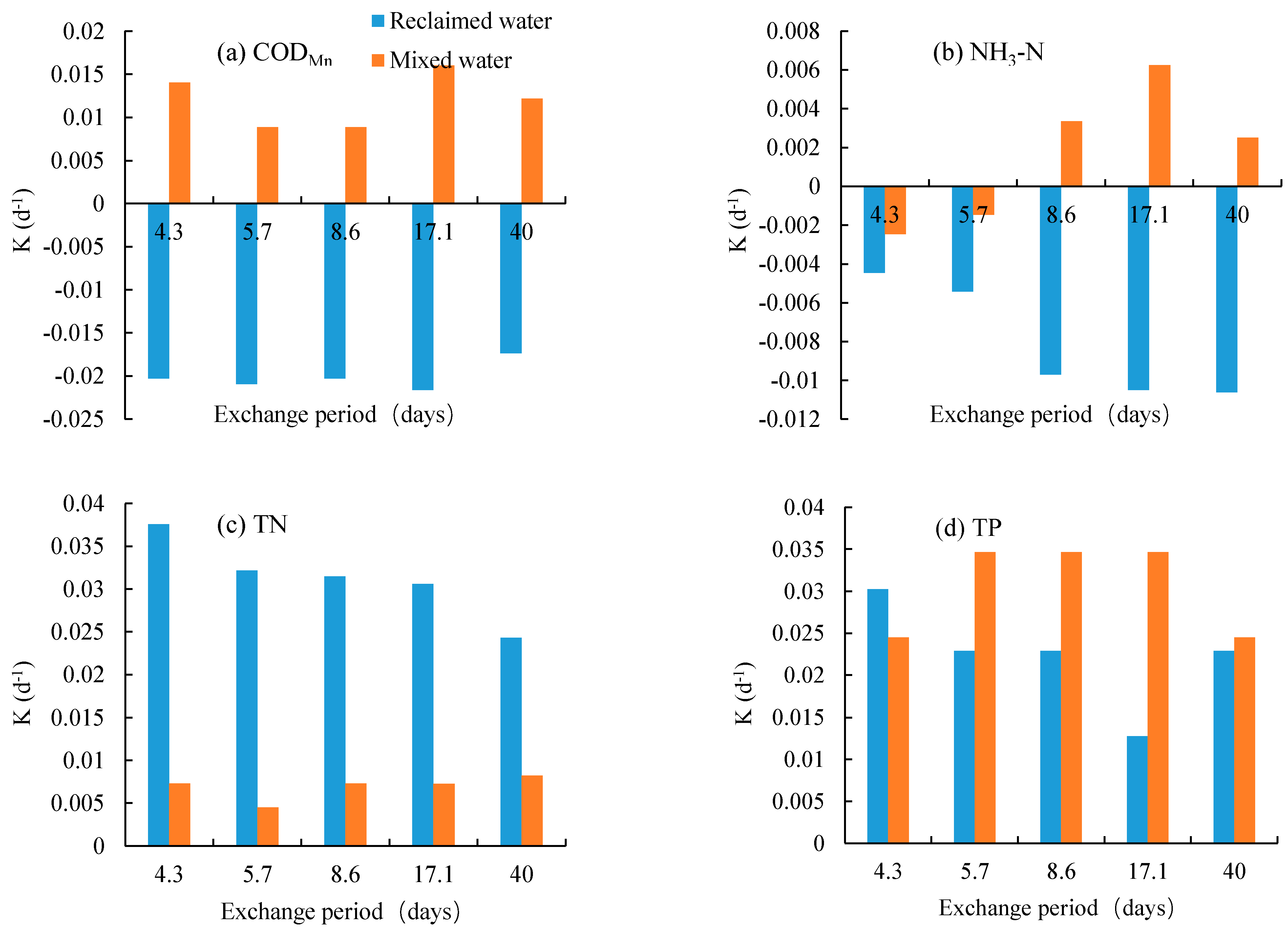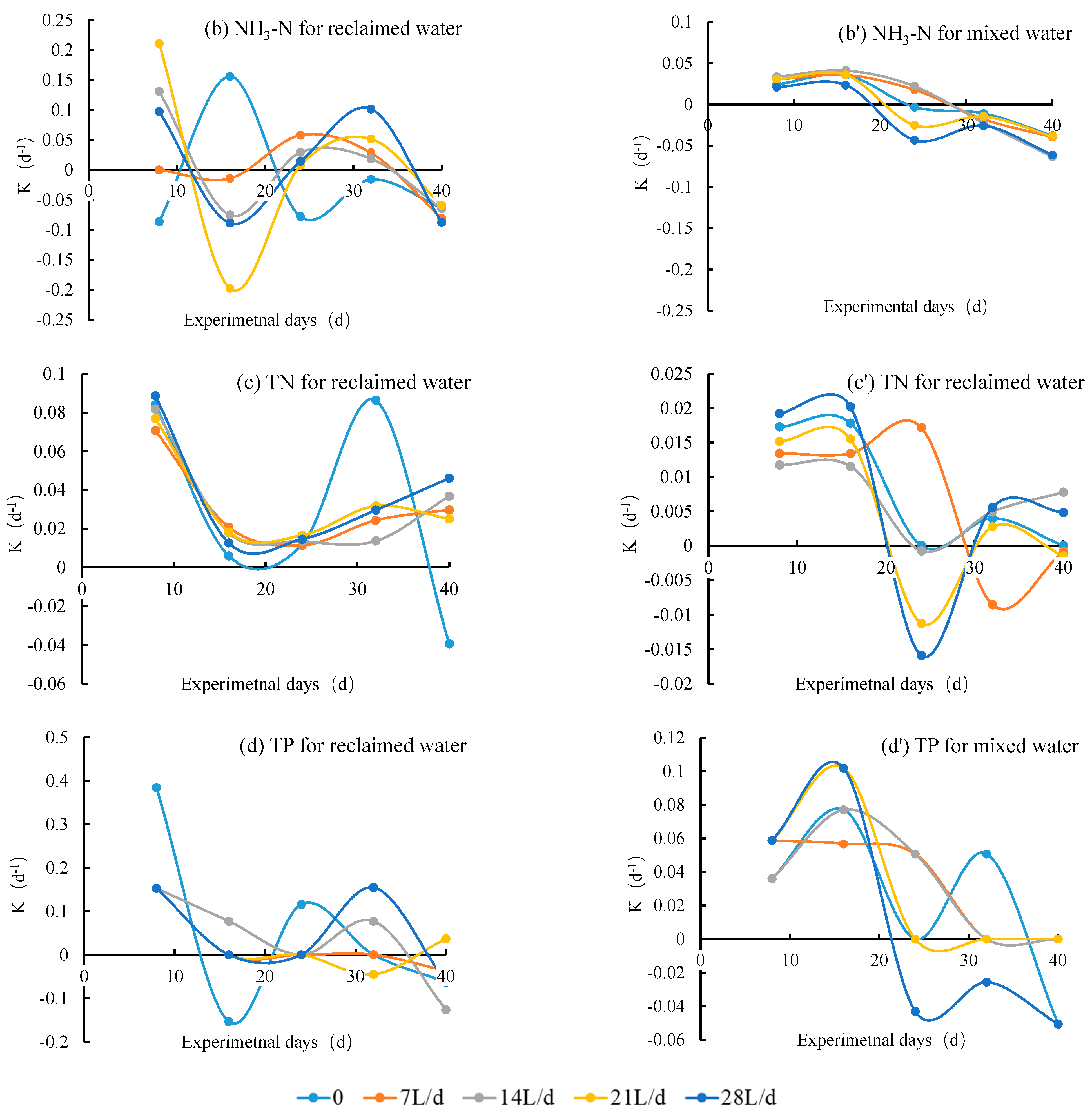A Simulation Experiment on Quality Dynamics of Reclaimed Water under Different Flow Exchanges
Abstract
:1. Introduction
2. Methods
2.1. Experimental Apparatus
2.2. Experimental Processes
- (1)
- Measurement of water quality dynamics
- (2)
- Soil microbial community
2.3. Pollutant Degradation Coefficient
2.4. Soil Microbial Community Richness and Diversity
3. Results and Analysis
3.1. Pollutant Concentration Dynamics under Different Exchange Flow Regimes
3.2. The Effect of Water Exchange Period on Degradation Coeffcicent
3.3. The Effect of the Water Exchange Period on Soil Microbial Communities
4. Discussion
4.1. Reclaimed Water Use
4.2. Water Exchange and Degradation Coefficient
4.3. Limitations of This Study
5. Conclusions
Author Contributions
Funding
Institutional Review Board Statement
Informed Consent Statement
Data Availability Statement
Conflicts of Interest
References
- Lyu, S.; Chen, W.; Zhang, W.; Fan, Y.; Jiao, W. Wastewater reclamation and reuse in China: Opportunities and challenges. J. Environ. Sci. 2016, 39, 86–96. [Google Scholar] [CrossRef]
- Cherchi, C.; Kesaano, M.; Badruzzaman, M.; Schwab, K.; Jacangelo, J.G. Municipal reclaimed water for multi-purpose applications in the power sector: A review. J. Environ. Manag. 2019, 236, 561–570. [Google Scholar] [CrossRef]
- Li, Q.; Wang, W.J.; Jiang, X.H.; Lu, D.L.; Zhang, Y.B.; Li, J.X. Analysis of the potential of reclaimed water utilization in typical inland cities in northwest China via system dynamics. J. Environ. Manag. 2020, 270, 110878. [Google Scholar] [CrossRef]
- Yi, L.; Jiao, W.; Chen, X.; Chen, W. An overview of reclaimed water reuse in China. J. Environ. Sci. 2011, 23, 1585–1593. [Google Scholar] [CrossRef]
- Li, X.; Sha, J.H.; Yan, J.J.; Zhang, G.F. The environmental and economic impact of reclaimed water utilization in Beijng-based on the dynamic optimal simulation method. Adv. Mater. Res. 2015, 1073–1076, 579–583. [Google Scholar] [CrossRef]
- Chang, N.N.; Zhang, Q.H.; Wang, Q.; Luo, L.; Wang, X.C.; Xiong, J.Q.; Han, J.X. Current status and characteristics of urban landscape lakes in China. Sci. Total Environ. 2020, 712, 135669. [Google Scholar] [CrossRef]
- Zhu, Z.; Dou, J. Current status of reclaimed water in China: An overview. J. Water Reuse Desal. 2018, 8, 293–307. [Google Scholar] [CrossRef] [Green Version]
- Deng, S.; Yan, X.; Zhu, Q.; Liao, C. The utilization of reclaimed water: Possible risks arising from waterborne contaminants. Contam. Environ. 2019, 254, 113020. [Google Scholar] [CrossRef]
- Tao, Y.; Lu, J. Occurrence of total phosphorus in surface sediments of Chinese lakes and its driving factors and im-plications. J. Hydrol. 2020, 580, 124345. [Google Scholar] [CrossRef]
- Zhang, X.Q.; Han, X.; Zhang, X.; Yang, S.Q.; Du, M.X. A partial feed nanofiltration system with stabilizing water quality for treating the sewage discharged from open recirculating cooling water systems. Sep. Purif. Technol. 2020, 234, 116045. [Google Scholar] [CrossRef]
- Pei, H.; Ma, J. Study on the algal dynamic model for west lake, Hangzhou. Ecol. Model 2002, 148, 67–77. [Google Scholar] [CrossRef]
- He, T.; Xiong, J.Q.; Wang, X.C.; Liu, Y.Z. Quality variations of landscape water with different ratio of reclaimed water supply. Chinese. J. Environ. Eng. 2016, 10, 6923–6927. (In Chinese) [Google Scholar]
- Liu, Y.Z. Study on Water Quality Characteristics and Regulation Technology of Urban Landscape Water Body under Reclaimed Water Recharge Condition. Ph.D. Thesis, Xi’An University of Architecture and Technology, Xi’an, China, 2019. [Google Scholar]
- Ćmiel, A.M.; Strużyński, A.; Wyrębek, M.; Lipińska, A.M.; Zając, K.; Zając, T. Response of freshwater mussel re-cruitment to hydrological changes in a eutrophic floodplain lake. Sci. Total Environ. 2020, 703, 135467. [Google Scholar] [CrossRef]
- Xu, M.; Bai, X.; Pei, L.; Pan, H. A research on application of water treatment technology for reclaimed water irrigation. Int. J. Hydrogen Energy 2016, 41, 15930–15937. [Google Scholar] [CrossRef]
- Kong, X.; Koelmans, A.A. Modeling decreased resilience of shallow lake ecosystems toward eutrophication due to microplastic ingestion across the food web. Environ. Sci. Technol. 2019, 53, 13822–13831. [Google Scholar] [CrossRef]
- Valis, D.; Hasilová, K.; Forbelská, M.; Pietrucha-Urbanik, K. Modelling water distribution network failures and deterioration. In Proceedings of the 2017 IEEE International Conference on Industrial Engineering and Engineering Management, Singapore, 10–13 December 2017; pp. 924–928. [Google Scholar] [CrossRef]
- Ahmad, A.; Rutten, S.; Eikelboom, M.; de Waal, L.; Bruning, H.; Bhattacharya, P.; van der Wal, A. Impact of phos-phate, silicate and natural organic matter on the size of Fe (III) precipitates and arsenate co-precipitation efficiency in calcium containing water. Sep. Purif. Technol. 2020, 235, 116117. [Google Scholar] [CrossRef]
- Kozyrev, S.V.; Volovich, I.V. The Arrhenius formula in kinetic theory and Witten’s spectral asymptotics. J. Phys. A-Math. Theor. 2011, 44, 215202. [Google Scholar] [CrossRef] [Green Version]
- Wang, X.; Li, J.; Chen, J.; Cui, L.; Li, W.; Gao, X.; Liu, Z. Water quality criteria of total ammonia nitrogen (TAN) and un-ionized ammonia (NH3-N) and their ecological risk in the Liao River, China. Chemosphere 2020, 243, 125328. [Google Scholar] [CrossRef]
- Qu, Y.; Wang, C.; Guo, J.; Huang, J.; Fang, F.; Xiao, Y.; Ouyang, W.; Lu, L. Characteristics of organic phosphorus fractions in soil from water-level fluctuation zone by solution 31P-nuclear magnetic resonance and enzymatic hydrolysis. Environ. Pollut. 2019, 255, 113209. [Google Scholar] [CrossRef]
- Hassan, I.F.; Alinier, G. The inaugural qatar critical care conference with its qatar medical journal special issue—An important milestone. Qatar Med. J. 2019, 2019, 1. [Google Scholar] [CrossRef]
- Hutchins, M.G.; Hitt, O.E. Sensitivity of river eutrophication to multiple stressors illustrated using graphical sum-maries of physics-based river water quality model simulations. J. Hydrol. 2019, 577, 123917. [Google Scholar] [CrossRef]
- Paerl, H.W.; Xu, H.; McCarthy, M.J.; Zhu, G.; Qin, B.; Li, Y.; Gardner, W.S. Controlling harmful cyanobacterial blooms in a hyper-eutrophic lake (Lake Taihu, China): The need for a dual nutrient (N & P) management strategy. Water Res. 2011, 45, 1973–1983. [Google Scholar] [CrossRef]
- Liu, D.; Du, Y.; Yu, S.; Luo, J.; Duan, H. Human activities determine quantity and composition of dissolved organic matter in lakes along the Yangtze River. Water Res. 2020, 168, 115132. [Google Scholar] [CrossRef]
- Wang, X.Y.; Pan, C.Z.; Liu, C.L.; Guo, Z.F. Experimental research on water quality evolution mechanism of landscape water bodies with different ratios of reclaimed water. South-North Water Transf. Water Sci. Technol. 2019, 17, 76–83. (In Chinese) [Google Scholar]
- Lee, B.J.; Kim, J.; Hur, J.; Choi, I.H.; Toorman, E.A.; Fettweis, M.; Choi, J.W. Seasonal dynamics of organic matter composition and its effects on suspended sediment flocculation in river water. Water. Resour. Res. 2019, 55, 6968–6985. [Google Scholar] [CrossRef]
- Ao, D.; Chen, R.; Wang, X.C.; Liu, Y.Z.; Dzakpasu, M.; Zhang, L.; Huang, Y.; Xue, T.; Wang, N. On the risks from sediment and overlying water by replenishing urban landscape ponds with reclaimed wastewater. Environ. Pollut. 2018, 236, 488–497. [Google Scholar] [CrossRef]







| Water Quality Indicators | Determination Method |
|---|---|
| pH | PHscan10S Pen type pH meter |
| Dissolved oxygen (DO) | Dissolved oxygen meter DO200A |
| Chemical oxygen demand (CODMn) | Automatic CODMn analyzer |
| Ammonia nitrogen(NH3–N) | Sodium reagent spectrophotometry |
| Total nitrogen (TN) | Titrimetric method after distillation |
| Total Phosphorus (TP) | Ammonium Molybdate Spectrophotometric Method |
| Electrical conductivity | 2265FS Portable conductivity meter |
| Water Quality Index | Reclaimed Water | Mixed Water |
|---|---|---|
| pH | 8.6 | 8.9 |
| Dissolved oxygen (mg/L) | 4.12 | 4.98 |
| Ammonia nitrogen (mg/L) | 0.36 | 0.03 |
| Nitrate nitrogen (mg/L) | 13.2 | 4.4 |
| Nitrite nitrogen (mg/L) | 0.03 | 0.03 |
| Chemical oxygen demand (CODMn) (mg/L) | 15 | 34 |
| Electrical conductivity (mS/cm) | 1.04 | 0.86 |
| Treatments (EFR) | Sequences | Sobs | Shannon | Simpson | Ace | Chao | Coverage | |
|---|---|---|---|---|---|---|---|---|
| Initial soil | 52,337.00 | 40.00 | 2.10 | 0.21 | 40.35 | 40.00 | 0.99 | |
| 0 (blank) | 42,166.00 | 35.00 | 1.98 | 0.20 | 39.44 | 37.00 | 0.99 | |
| Re | 7 L d−1 | 41,923.00 | 42.00 | 1.91 | 0.25 | 45.28 | 43.50 | 0.99 |
| 14 L d−1 | 44,819.00 | 43.00 | 2.23 | 0.16 | 44.77 | 43.60 | 0.99 | |
| 21 L d−1 | 44,241.00 | 41.00 | 2.05 | 0.21 | 42.95 | 42.50 | 0.99 | |
| 28 L d−1 | 42,071.00 | 36.00 | 1.87 | 0.23 | 46.01 | 38.00 | 0.99 | |
| 0 (blank) | 45,228.00 | 38.00 | 2.05 | 0.21 | 44.80 | 41.00 | 0.99 | |
| 7 L d−1 | 42,423.00 | 39.00 | 1.93 | 0.20 | 41.83 | 42.00 | 0.99 | |
| Mix | 14 L d−1 | 36,502.00 | 39.00 | 1.71 | 0.31 | 40.65 | 40.50 | 0.99 |
| 21 L d−1 | 42,777.00 | 42.00 | 1.95 | 0.23 | 44.35 | 42.75 | 0.99 | |
| 28 L d−1 | 40,726.00 | 39.00 | 2.15 | 0.19 | 39.33 | 39.00 | 0.99 |
Publisher’s Note: MDPI stays neutral with regard to jurisdictional claims in published maps and institutional affiliations. |
© 2022 by the authors. Licensee MDPI, Basel, Switzerland. This article is an open access article distributed under the terms and conditions of the Creative Commons Attribution (CC BY) license (https://creativecommons.org/licenses/by/4.0/).
Share and Cite
Pan, C.; Guo, Z.; Luo, M. A Simulation Experiment on Quality Dynamics of Reclaimed Water under Different Flow Exchanges. Int. J. Environ. Res. Public Health 2022, 19, 13091. https://doi.org/10.3390/ijerph192013091
Pan C, Guo Z, Luo M. A Simulation Experiment on Quality Dynamics of Reclaimed Water under Different Flow Exchanges. International Journal of Environmental Research and Public Health. 2022; 19(20):13091. https://doi.org/10.3390/ijerph192013091
Chicago/Turabian StylePan, Chengzhong, Zhongfang Guo, and Mingjie Luo. 2022. "A Simulation Experiment on Quality Dynamics of Reclaimed Water under Different Flow Exchanges" International Journal of Environmental Research and Public Health 19, no. 20: 13091. https://doi.org/10.3390/ijerph192013091





